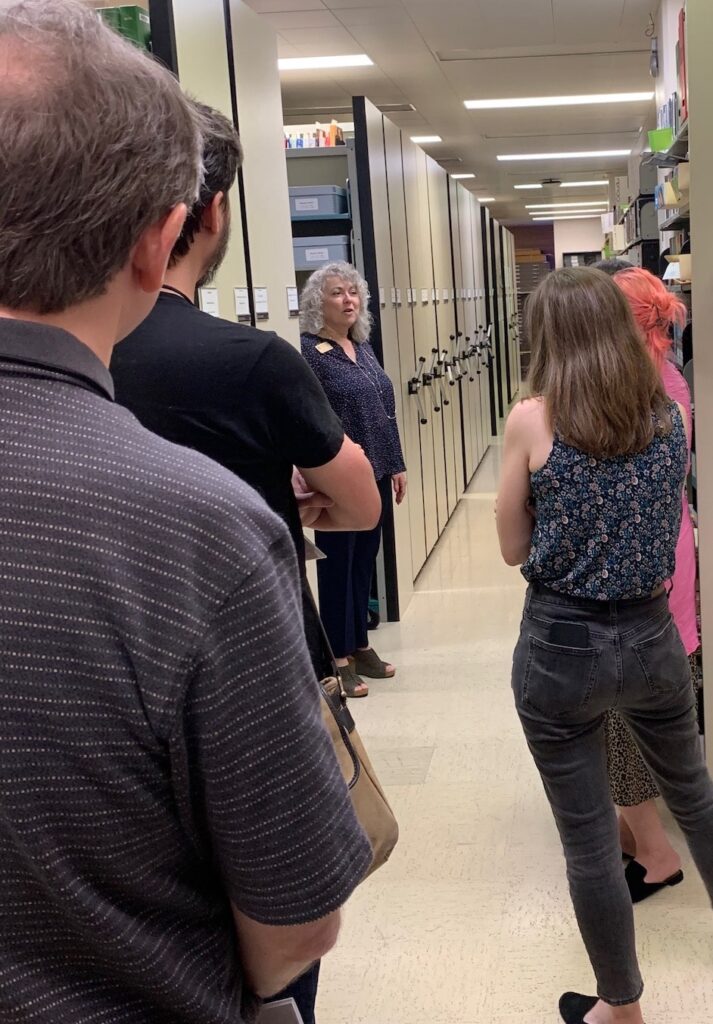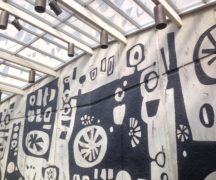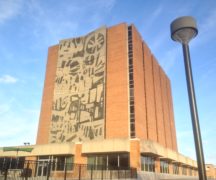By JULIE CARLE
BG Independent News
Fifteen academic researchers spent several days in a popular culture scavenger hunt of sorts looking for clues and tidbits of information to give depth and details to their research.
Jeffrey Roessner from Mercyhurst University was searching for information to advance his topic, “Better All the Time: The Beatles, Identity, and the Pop Aesthetic.”
Erin Casey-Williams from Nichols College in Massachusetts studied hundreds of pages of Little Blue Books to amplify her research, “Accessible Ephemera: Little Blue Books, Literature, and Dying Art.”
The University of Arkansas doctoral student David Farris dove deep into Teenage Mutant Ninja Turtles comic books hoping for inspiration to link the turtles to his favorite author William Faulkner. His research is titled “Examining Thematic Connections Between William Faulkner and the Teenage Mutant Ninja Turtles.”
They were among the participants in Bowling Green State University’s recent Popular Culture Research Institute hosted by BGSU University Libraries and the Popular Culture Association. During the institute, researchers dug into fanzines, comic books, magazines, records, catalogs and Romance Writers of America correspondence from the unique and coveted collections within the Ray and Pat Browne Library for the Study of Popular Culture and the Music Library and Bill Schurk Sound Archives.
The special collections, which are some of the most significant of their kind, drew scholars from around the world. The information uncovered from the primary sources lent credence to the scholars’ research.
Roessner, who is an English professor and associate dean at Mercyhurst, found a treasure trove of knowledge within fanzines, records and articles in his search to better understand the transition of the Beatles’ reputations over the years. He has written numerous essays and chapters about the Beatles; his current goal is to write a book
Because there was an abundance of useful information, he took photos and scanned the materials for later review, following the advice given by Tyne Lowe, manuscript archivist for the pop culture library. Before the participants began the research, she recommended they “suck all the information you can in the time you are here and analyze later.”
“It was fascinating for me to see the band’s reputation evolve. Looking at the early materials, even into the ‘70s, they are not treated as heroes or gods. They hadn’t ascended to the stratosphere yet. They are just ‘60s musicians. But then you can see the narrative sort of come together about them as the transcendent rock and roll saviors that they are,” Roessner said.
The pop culture library’s Star Trek collection–from books and journals to posters, games and trading cards–was especially helpful to two researchers.
Hélène Lupa, who traveled from American University in Washington, D.C., looked at fan magazines from the mid-1970s for her research titled, “For Honor Sometimes: Klingon Transformations Across Star Trek Transmedia Productions.”
With only two episodes of Star Trek in the magazines she reviewed, Lupa ended up extrapolating new stories and concepts about the Klingons and anticipated some of the plot lines and cultural ideas that would be added to later shows and movies.
“I found a lot of great stuff. It was a wonderful opportunity to work with a collection that had such great diversity,” she said.

The Star Trek collection also contributed to Michelle Tabit’s research for her topic: “To Boldly Go Where Women Were Not Welcome: Exploring Women’s Contributions to Star Trek Fandom Through Fanzines.”
Tabit, who is an associate professor of history at the University of the Incarnate Word, found “super slick and glossy” publications that came from publishing houses rather than from fans. “Those focused on the episodic nature of things, such as technology, how they created the Enterprise,” she explained.
When she studied the fanzines that were produced in people’s homes, she discovered the content was significantly different. “It was interesting to see the women from different walks of life–librarians, college professors and women who were married to promoters–who developed the zines themselves. They were the ones who spearheaded the letter-writing campaign to try and save Star Trek,” Tabit said.
They decided if NBC Paramount was going to take the show off of TV that they would write their own stories because they wanted to fill in the gaps from the show and explore Vulcan and Romulus cultures.
“What’s really important is that fanzines have been around since the 1930s, but Star Trek fanzines took it in a whole new dedicated direction. As we get to the 21st century, these women who have been putting together the zines and folding the paper copies, are starting to direct people where to go online,” Tabit said.
Farris’s project, which involved a deep dive into Teenage Mutant Ninja Turtles’ comic books, blends his childhood delights with his current interests as a Faulkner scholar. An interesting find for him was a critical text that referenced why the turtles were bad for children, creating “a fear-mongering layer that “God wouldn’t want you to let your kids watch,” Farris said, possibly tying into Faulkner’s focus on the rise of the degenerate family.
Casey-Williams was intrigued with the Little Blue Books and their content. They are small staple-bound books printed between 1919 and 1978 and designed to fit into a working man’s pocket and foster ideals of American socialism.
“The topics were so different, but the cool thing was kind of pulling threads out,” she said. Some of the owners had put their names in the books. Others underlined or circled some of the text; which made it obvious to see how much of the book had been read. She was surprised to find items left behind tucked inside the tiny pages—a four-leaf clover, a ticket stub and a poem.
Alex Eschbach, a journalism and mass communication graduate student at University of Oklahoma, chose to attend the research institute for his own pleasure rather than for dissertation-specific academic research. He scoured through tons of punk zines for his topic of choice, “Punks Want a Suburban House.”
With punk beliefs based on non-conformity and anti-corporate greed, he found it interesting to find ads within the zines and wondered “how the capitalistic ideal of advertising might have played into the anti-capitalistic ideals of punkers.”

As a staff member who helped identify sources, research archivist Dana Nemeth shared her favorite moment of the week. Saadia Lawton from the University of the Arts was interested in Sesame Street realia for her study on “Sustaining the Audience: A New Model for Collecting and Exhibiting Pop Art.”
Lawton had identified a Sesame Street Ernie pull toy and she wondered what he used to say, Nemeth explained. “I went to the 1976 JC Penney Christmas Catalog and there he was. She found it and was able to answer at least two of the things he said. That is exciting for us to make connections like that to solve such mysteries.”
The conference is one of the most exciting events the pop culture library hosts, said Nancy Down, head librarian for the pop culture library, “We get to see a lot of people using materials in the collection that don’t always get used on a regular basis. It’s kind of exciting to see the collection in different ways through different eyes.”





